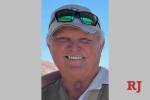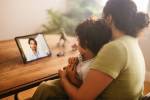Complete Prevention: Woman opts for double mastectomy to avoid sister’s fate
Too often in her memories, Shiela Burns sees what terrifies her.
Blood at first seeping, then spurting from tumors on the chest and back of her twin sister, Las Vegas optometrist Dr. Sheryl Potter-Peccole, whose breast cancer metastasized into the skin of her upper torso. Tightly wrapped in a blanket in an effort to stanch the bleeding, Sheryl sobs after collapsing on the bathroom floor from losing too much blood.
Burns recalls the gut-wrenching sight of Sheryl and husband Robert Peccole’s children — Robbie, then 9 and Katie, 8 — weeping during their mommy’s funeral.
Horrific memories, not a medical diagnosis, have the 46-year-old Burns on the operating table on this August morning at Sunrise Hospital and Medical Center.
Burns had a cancerous tumor removed from near her breast last winter, but every test she’s taken since shows she does not have cancer in either breast. But at her request, she will undergo a preventive double mastectomy.
The operation should greatly minimize Burns’ risk of getting breast cancer, which has attacked her family four times. But it doesn’t carry a guarantee.
“I want to do all I can to prevent ending up like the sister I loved so much,” Burns says before her operation. “If I don’t, and end up with cancer, I’d have no one to blame but me.”
Since Breast Cancer Awareness Month began nearly 30 years ago, many who have fought the disease that still kills 40,000 Americans each year have shared their stories, hoping that by keeping a spotlight on a scourge that spawns more than 230,000 new cases annually, the search for a cure will be pursued with a greater sense of urgency. Burns wants to add her voice.
FRIGHTENING FAMILY LEGACY
It is a week before her Aug. 16 surgery as Burns, a counselor at Centennial High School, stands near the sparkling pool outside her northwest Las Vegas home. Her children, 20-year-old Morgan, a student at the University of Northern Arizona, and 16-year-old Zach, a junior at Centennial, are with her.
On their wrists are bracelets that the family had made — many of their friends wear them, too — that bear the inscription “Fighting For Shiela.”
Already breast cancer has left two wounded and two dead in their family.
Tim Burns, to whom Shiela has been married for 22 years, is in Utah, on a business trip for his construction business. “Tim’s been great,” his wife says as she enters the house. “He saw what my sister went through. He tells me, ‘Whatever you need, I’ll be right there.’ And he has.”
When Burns talks about how breast cancer has affected her family, tears well up in Morgan’s eyes. Scared, she’s already started asking doctors if she can get tested for the disease before her 21st birthday. Zach, who’ll be too nervous to accompany his mother to the hospital for her operation, looks at the floor.
She was just 5 years old, Burns says, when her dad’s mother died of breast cancer. Later, she remembers the fear that spread through the family when her mother was diagnosed 15 years ago. Now 70, her mother has survived the disease after a single mastectomy, chemotherapy and radiation.
It was eight years ago, Burns says, when her twin, then 38, was diagnosed with triple negative breast cancer, which experts say isn’t receptive to most successful treatments for the disease. Still, it is typically responsive to chemotherapy.
Depending on the stage at diagnosis, cancer researchers say triple negative breast cancer can be particularly aggressive and more likely to recur than other subtypes of breast cancer.
A year after her sister was treated, apparently successfully, with chemotherapy and radiation, Burns says the cancer came roaring back. Nothing worked at halting it. A single mastectomy was tried. It never healed, and it wasn’t long until her sister developed open sores on the upper part of her body that began to bleed for no apparent reason. Doctors said they had never seen anything like it.
“It was horrific,” Burns recalls.
Morgan admits the experiences with her aunt are so seared into her psyche that she envisions them occurring to her in just a few years.Once, she says, she received a frantic call for help from her aunt’s children.
When she got to the house, she noticed blood spatter on the floor wherever her aunt had walked.
“She fell, just too weak to stand,” she says. “We got her an emergency blood transfusion at the hospital.”
Burns traveled with her sister when she sought help from the M.D. Anderson Cancer Center in Texas, the Huntsman Cancer Institute in Utah and the City of Hope Comprehensive Cancer Center in California.
Renowned cancer specialists couldn’t help the woman, who had become frighteningly thin.
A month after her sister died in October 2011, Burns felt a tiny nodule in her right armpit, in tissue close to her right breast. Stunned, she went to doctors for tests. They were negative, but she was put on tamoxifen, a medication used to reduce the risk of developing breast cancer.
Every few months Burns underwent tests on the soft pimple. For a year, no problems. But this past January, she sensed the growth was harder and larger. Her dermatologist, Dr. Doug Thomas, removed it to give her peace of mind. Though he doubted it was cancerous, he sent it to a pathologist.
While shopping for groceries in February, Burns received a call from a solemn Thomas, whom she remembers saying, “I need to discuss things with you.” She sensed it wasn’t good news.
“‘I’m afraid it isn’t,’” she remembers him saying. “I thought I was going to pass out.”
Right then, she says, she decided that no matter what doctors said, she would have a double mastectomy. “They can take them,” she recalls crying to her husband. “I don’t want the risk.”
BUOYED BY SUPPORT
Word of her cancer quickly spread through Centennial High School.
“I was in shock,” recalls senior Cristina Owens. “She’s the person at our school everybody goes to because she’s so understanding. We can be completely open with her. She’s our mom at school. We knew she hurt from the death of her sister from breast cancer. But she was so strong, always ready to help us.”
Overnight, several students, Owens recalls, got boxes of T-shirts and tie-dyed them pink so students could wear them in support of Burns’ battle with cancer. More than 100 students wore them at the Centennial High School basketball semifinal playoff game at The Orleans in February.
Emotional over the daily outpouring of caring shown by staff and students — fruit baskets and cards were plentiful — she admits she was also tense about a “cleanup surgery” in her armpit that was done last winter by Comprehensive Cancer Centers of Nevada breast surgeon Dr. Josette Spotts. Because the growth removed by the dermatologist was so close to Burns’ right breast tissue, she technically had breast cancer. Spotts found no further evidence of the disease.
To be safe, Burns took months of chemotherapy that ended in July. Repeatedly, scans have shown no cancer.
“She still wanted the surgery that reduces her risk of breast cancer by 98 to 99 percent,” Spotts recalls before performing the double mastectomy. “It was not something I talked her into. Given her family history, however, I certainly understood why she wanted to.”
Given that she is an identical twin, it mystified doctors and Burns that tests showed she did not have the same genetic triple negative subtype of cancer as Sheryl. “It’s a biological mystery,” Spotts says.
She also doesn’t have BRCA1 or BRCA2 genetic mutations associated with increasing a woman’s lifetime risk of developing breast cancer by 87 percent.
For women who test positive for those mutations, removing both breasts has become largely supported by the medical community as a cancer-prevention option, one Oscar-winning actress Angelina Jolie took this year.
Solid statistics aren’t available for what Burns is having done, though Spotts and cancer surgeons across the country say they’ve been asked to do more preventive double mastectomies to give patients peace of mind.
Private insurance companies should have the best information on women opting to have surgery for a medical condition they don’t have, but that data isn’t being shared with the public.
A study of women between 1998-2003 found that the number of women with cancer in one breast who elect to have the other noncancerous breast excised as well more than doubled, from 1.8 percent to 4.5 percent.
Doctors warn it is major surgery with significant risks.
Burns says it shouldn’t be a mystery as to why more women are risking preventive surgery.
“Doctors don’t know why we develop cancer. So why should we think they know if it’s going to come back?” she says. “To reduce the risk with a surgery by 98 or 99 percent, you can’t get much better than that.”
surgery offers hope
The sounds of “Sweet Home Alabama” — Burns asked that country music play during her surgery — fill the operating room. Because Burns has chosen to have breast reconstruction, Spotts will perform what are known as skin-sparing mastectomies.
Using an electrocautery device to dissect tissue — high frequency electric currents instantly stop bleeding — she removes breast tissue through a small incision around the areola area of the nipple, leaving most of the breast skin. Natural skin envelopes, or pockets, are created, which plastic surgeon Dr. Cameron Earl will soon fill with tissue expanders.
Even before Spotts finishes with Burns’ right breast, Earl begins to work on the left side where tissue has been removed. He places a tissue expander, similar to a balloon, under chest muscle. The tissue expander has a small valve he can access.
(Over the next few months he will inject saline into the valve, filling the balloon in stages. A gradual process, it allows Burns’ skin to stretch over time. Once the tissue expansion is complete, Earl will schedule a surgery to remove the tissue expanders and replace them with permanent implants.)
After Spotts finishes on the right breast, Earl repeats the tissue expander process there.
A little more than four hours after Burns was wheeled into surgery, she is wheeled out.
In recovery for most of the afternoon, she heads home with family in the early evening, making them stop to get her a green tea from Starbucks. As difficult as it is to believe, she joins them at the dinner table that night to eat food friends have brought over.
A month and a half has passed since Burns’ surgery. Her hair is still growing out from the earlier chemotherapy. Much of the soreness in her chest has left. She’s off pain medication. She can sleep lying down again, not sitting up. She can also raise her arms above her head.
She missed only two weeks from school.
Her husband, who helped her deal with the drainage tubes that had been temporarily implanted to remove excess fluids that collect in the surgical site, marvels at her resiliency.
“One reason I married her is because I knew she was tough,” he says. “But I didn’t know just how tough.”
She’ll have to be tougher still.
Even though tests that Spotts did on the tissue she removed showed again that there is no sign of cancer, Burns will begin, at the end of this month, several weeks of energy-sapping radiation therapy on the area where the cancerous nodule was first detected.
“I told my doctors I want to do all I can to beat breast cancer,” she says. “So that’s what we’re doing.”
Contact reporter Paul Harasim at pharasim@reviewjournal.com or 702-387-2908.

October is Breast Cancer Awareness Month. For more coverage, click here.

































